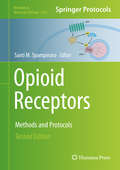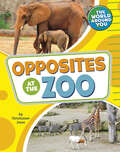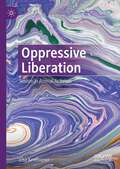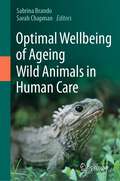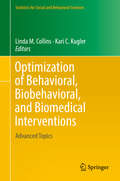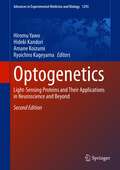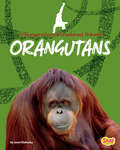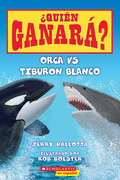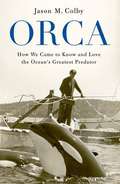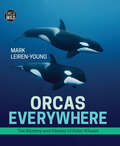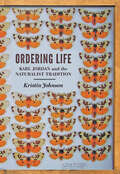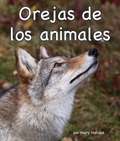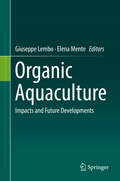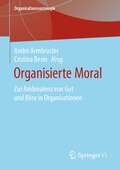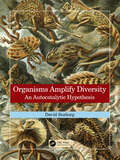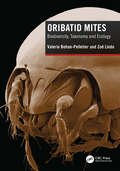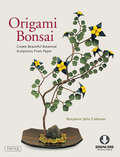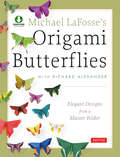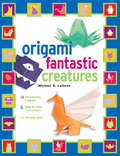- Table View
- List View
Opioid Receptors: Methods and Protocols (Methods in Molecular Biology #2201)
by Santi M. SpampinatoThis second edition presents an up-to-date chapters describing the most relevant and novel techniques employed to study the opioid receptors. Chapters detail transcriptional and post-transcriptional analysis, cellular detection of opioid receptors, analysis of signaling events modulated by opioid receptors, model systems to studying opioid receptor-mediated functions, and behavioral effects mediated by opioid receptors. Written in the highly successful Methods in Molecular Biology series format, chapters include introductions to their respective topics, lists of the necessary materials and reagents, step-by-step, readily reproducible laboratory protocols, and tips on troubleshooting and avoiding known pitfalls. Authoritative and cutting-edge, Opioid Receptors: Methods and Protocols, Second Edition aims to ensure successful results in the further study of this vital field.
Opossum (Nature's Children)
by Laima DingwallHow is the opossum related to the Tasmanian Devil? Is an opossum bigger or smaller than a house cat? What happens when an opossum "plays dead"? Find the answers to these questions, and learn much more about the physical characteristics, behavior, habitat, and lives of opossums.
Opposites at the Zoo (The World Around You)
by Christianne JonesBig, stomping elephants. Small, colorful birds. Tall, spotted giraffes. Short, waddling penguins. Opposites are all around at the zoo! This picture book brings opposites from the zoo to young children with interactive, rhyming text and bright photographs.
Opposnakes: A Lift-the-flap Book About Opposites
by Salina YoonSwing open the giant flaps over each adorable snake to reveal which extra-long opposnake is waiting for them. This book features simple opposites such as clean to dirty, quiet to loud, hot to cold, and a grand finale of one lonely snake becoming lots and lots of snakes having a party! With its simple, graphically inspired illustrations, this book will delight children of all ages.
Oppressive Liberation: Sexism in Animal Activism
by Lisa KemmererWhile explicitly set against a backdrop of sexism in social justice activism more generally, this book exposes causes, pervasiveness, harms, and possible directions for change with regard to sexism and male privilege in the animal activist movement. Employing the work of previous scholars, Dr. Lisa Kemmerer exposes the commonplace nature and causes of sexism and male privilege in social justice activism, then focuses on anymal activists, including new data that has not previously been published. The book also explores the crushing harms caused by sexism in the movement and an extensive array of possible directions for change. In various places throughout the text, Kemmerer refocuses on the interface of sexism and speciesism, and one full chapter explores a philosophies of interconnection from around the world and down through time. Also included are six essays from contributing authors who offer fresh angles on the topic, and who provide contextualized experiences with intersectional oppressions. While the book focuses specifically on animal activism, the end-goal of the book is total liberation—an end to all forms of privilege and marginalization.
Optimal Wellbeing of Ageing Wild Animals in Human Care
by Sarah Chapman Sabrina BrandoMany wild animals in human care live longer than their wild counterparts because of modern care and wellbeing programmes, leading to a growing demographic of ageing animals. This handbook is dedicated to their care. As an innovative expert publication, it integrates all aspects of professional care, including topics such as behaviour, ethics, environmental enrichment, training, veterinary care, nutrition and habitat design. Each animal is unique in their preferences, physical and emotional needs. Ageing animals may change their behaviour, alter the use space, and may also experience events and their relationships with their carers differently than they used to. The ageing process and death of an individual can be a significant event for others in their group, as well as the human carers.This book consolidates best practices for supporting and assessing optimal ageing animal wellbeing. It describes practical and science-informed approaches and philosophies regarding the care of ageing wild animals in zoos, aquariums, sanctuaries, universities and laboratories in a single source. This is an invaluable reference for veterinarians, animal care professionals, animal welfare researchers and students, and anyone with an interest in caring for animals.Personal stories and beautiful images of ageing individuals brightening the start of each chapter and remind us that what we do must be in the best interest of the animal and be at the heart of their care.
Optimization of Behavioral, Biobehavioral, and Biomedical Interventions: Advanced Topics (Statistics for Social and Behavioral Sciences)
by Linda M. Collins Kari C. KuglerBehavioral, biobehavioral, and biomedical interventions are programs with the objective of improving and maintaining human health and well-being, broadly defined, in individuals, families, schools, organizations, or communities. These interventions may be aimed at, for example, preventing or treating disease, promoting physical and mental health, preventing violence, or improving academic achievement. This book provides additional information on a principled empirical framework for developing interventions that are more effective, efficient, economical, and scalable. This framework is introduced in the monograph, "Optimization of Behavioral, Biobehavioral, and Biomedical Interventions: The Multiphase Optimization Strategy (MOST)" by Linda M. Collins (Springer, 2018). The present book is focused on advanced topics related to MOST. The chapters, all written by experts, are devoted to topics ranging from experimental design and data analysis to development of a conceptual model and implementation of a complex experiment in the field. Intervention scientists who are preparing to apply MOST will find this book an important reference and guide for their research. Fields to which this work pertains include public health (medicine, nursing, health economics, implementation sciences), behavioral sciences (psychology, criminal justice), statistics, and education.
Optogenetics: Light-Sensing Proteins and Their Applications in Neuroscience and Beyond (Advances in Experimental Medicine and Biology #1293)
by Ryoichiro Kageyama Hiromu Yawo Hideki Kandori Amane KoizumiThis book, now in a thoroughly revised second edition, offers a comprehensive review of the rapidly growing field of optogenetics, in which light-sensing proteins are genetically engineered into cells in order to acquire information on cellular physiology in optical form or to enable control of specific network in the brain upon activation by light. Light-sensing proteins of various living organisms are now available to be exogenously expressed in neurons and other target cells both in vivo and in vitro. Cellular functions can thus be manipulated or probed by light. The new edition documents fully the extensive progress since publication of the first edition to provide an up-to-date overview of the physical, chemical, and biological properties of light-sensing proteins and their application in biological systems, particularly in neuroscience but also in medicine and the optical sciences. Underlying principles are explained and detailed information provided on a wide range of optogenetic tools for the observation and control of cellular signaling and physiology, gene targeting technologies, and optical methods for biological applications. In presenting the current status of optogenetics and emerging directions, this milestone publication will be a “must read” for all involved in research in any way related to optogenetics.
Orangutan School (Fountas & Pinnell LLI Red #Level M)
by Katy DuffieldEstablished in 1964 the Sepilok Rehabilitation Center the island of Borneo was one of the first centers founded to assist orphaned orangutans. At this school students study fun and unusual subjects such as swinging, climbing and nest building.
Orangutans (Endangered And Threatened Animals)
by Janet RieheckyWhat’s that red-haired animal swinging through the rain forest’s trees seemingly without a care in the world? It’s an orangutan! Aside from all that red hair, these beautiful beasts look almost human, but they’re a lot stronger. Learn more about these colorful animals, including how they live, how clever they are, how they’re dealing with a shrinking habitat, and what you can do to help.
Orangutans (Nature's Children)
by Sheila DaltonWonder where these monkeys live? What they eat? How they get around? Read this book and find out.
Orca vs. Tiburón blanco (¿Quién ganará?)
by Jerry PallottaWhat would happen if a great white shark and a killer whale met each other? What if they had a fight? Who do you think would win?Este lector de no-ficción compara y contrasta dos feroces criaturas submarinas. Los pequeños aprenderán sobre la anatomía, el comportamiento y más de la orca y el tiburón blanco. Este libro está lleno de fotos, gráficos, ilustraciones y datos increíbles.This nonfiction reader compares and contrasts two ferocious underwater creatures. Kids learn about the killer whale and the great white shark's anatomies, behaviors, and more. This book is packed with photos, charts, illustrations, and amazing facts.
Orca: How We Came to Know and Love the Ocean's Greatest Predator
by Jason ColbySince the release of the documentary Blackfish in 2013, millions around the world have focused on the plight of the orca, the most profitable and controversial display animal in history. Yet, until now, no historical account has explained how we came to care about killer whales in the first place. <p><p> Drawing on interviews, official records, private archives, and his own family history, Jason M. Colby tells the exhilarating and often heartbreaking story of how people came to love the ocean's greatest predator. Historically reviled as dangerous pests, killer whales were dying by the hundreds, even thousands, by the 1950s--the victims of whalers, fishermen, and even the US military. In the Pacific Northwest, fishermen shot them, scientists harpooned them, and the Canadian government mounted a machine gun to eliminate them. But that all changed in 1965, when Seattle entrepreneur Ted Griffin became the first person to swim and perform with a captive killer whale. The show proved wildly popular, and he began capturing and selling others, including Sea World's first Shamu. <p> Over the following decade, live display transformed views of Orcinus orca. The public embraced killer whales as charismatic and friendly, while scientists enjoyed their first access to live orcas. In the Pacific Northwest, these captive encounters reshaped regional values and helped drive environmental activism, including Greenpeace's anti-whaling campaigns. Yet even as Northwesterners taught the world to love whales, they came to oppose their captivity and to fight for the freedom of a marine predator that had become a regional icon. <p> This is the definitive history of how the feared and despised "killer" became the beloved "orca"--and what that has meant for our relationship with the ocean and its creatures.
Orcas (Nature's Children)
by Geoff MillerWhy are killer whales black and white? Why are they called killer whales? Read this book and find out.
Orcas Everywhere: The History and Mystery of Killer Whales (Orca Wild #1)
by Mark Leiren-YoungOrcas are found in every ocean on the planet. But can they survive their relationship with humans? Orcas Everywhere looks at how humans around the world (Indigenous and non-Indigenous alike) related to orcas in the past, how we relate to them now and what we can do to keep cetacean communities alive and thriving. The book deals with science, philosophy, environmentalism and ethics in a kid-friendly and accessible way. Writer, filmmaker and orca activist Mark Leiren-Young takes us back to when killer whales were considered monsters and examines how humans went from using orcas for target practice to nearly loving them to death. If you know a young person who loves Free Willy or Finding Nemo, they will fall in love with these whales.
Ordering Life: Karl Jordan and the Naturalist Tradition
by Kristin JohnsonThis biography of the eminent naturalist explores his life and pioneering work through the rapidly changing world of 19th and 20th century science.For centuries naturalists have endeavored to name, order, and explain biological diversity. Born in 1861, Karl Jordan dedicated his long life to this project, describing thousands of new species in the process. Ordering Life celebrates Jordan’s distinguished career as an entomologist and chronicles his efforts to secure a place for natural history museums and the field of taxonomy.In the face of a changing scientific landscape, Jordan was determined to practice good taxonomy while also pursuing status and patronage—an effort that included close collaboration with the Rothschilds. Biographer Kristin Johnson traces the evolution of Jordan’s work through wars, economic fluctuation, and political upheaval, demonstrating that the broader social context is an essential aspect of naming, describing, classifying, and, ultimately, explaining life.
Orejas de los animales
by Mary HollandEl sentido del oído es muy importante para la supervivencia de los animales. Provee información vital a los animales que los ayuda a encontrar comida o a escuchar a los depredadores que están listos para atacar. Esta continuación del libro premiado de Mary Holland, de la serie Anatomía de los animales y sus adaptaciones, presenta una amplia variedad de orejas de animales y cómo estos las utilizan. ¿Sabías tú que algunos animales tienen los oídos en las patas? Al igual que los ojos, bocas, patas y colas presentados en libros previos, las orejas de los animales tienen una amplia variedad de formas y tamaños, la combinación perfecta para las necesidades de cada animal. El sentido del oído es muy importante para la supervivencia de los animales. Provee información vital a los animales que los ayuda a encontrar comida o a escuchar a los depredadores que están listos para atacar. Esta continuación del libro premiado de Mary Holland, de la serie Anatomía de los animales y sus adaptaciones, presenta una amplia variedad de orejas de animales y cómo estos las utilizan. ¿Sabías tú que algunos animales tienen los oídos en las patas? Al igual que los ojos, bocas, patas y colas presentados en libros previos, las orejas de los animales tienen una amplia variedad de formas y tamaños, la combinación perfecta para las necesidades de cada animal.
Organic Aquaculture: Impacts and Future Developments
by Giuseppe Lembo Elena MenteThis book addresses, reviews and evaluates key themes in organic aquaculture and is set out to show how these relate to the challenges and bottlenecks for a responsible organic aquaculture production in Europe. The key themes reflect the main challenges facing the organic aquaculture industry: guarantee and certification system, nutrition, reproduction, production system design and animal welfare. In addition, it assesses the impact of new and future potential development of new knowledge to update and modify the criteria and standards for organic aquaculture. Organic aquaculture is an alternative production approach driven by the growing interest in sustainable utilization of resources. It is rightly viewed as an important contributor to the economy and to the well-being and health of communities. This work will contribute to the scientific knowledge that needs to strengthen effective organic aquaculture. The collation of information on research and data will be of applied value to researchers, university students, end users and policy authorities in the EU and worldwide.
Organisierte Moral: Zur Ambivalenz von Gut und Böse in Organisationen (Organisationssoziologie)
by Cristina Besio André ArmbrusterDer Band untersucht, inwieweit moralisch gutes oder schlechtes Handeln organisiert werden kann. Die Diskussion soziologischer Erklärungen des normativ Guten und Bösen in und von Organisationen beleuchtet den ambivalenten Zusammenhang von Moral und Organisation, da Organisationen sowohl für moralische Anliegen eintreten als auch moralisch-ethische Normen (teilweise sogar absichtlich) verletzen. Diese Ambivalenz adressiert der Band durch theoretisch-konzeptionelle Beiträge sowie durch empirische Studien. Der Band zeigt damit die große Varietät in der empirischen Beobachtbarkeit und der sozialwissenschaftlichen Analyse der Moralität von Organisationen – ohne selbst für oder gegen Moral zu argumentieren.
Organisms Amplify Diversity: An Autocatalytic Hypothesis
by David SeaborgThis book presents a hypothesis and evidence that organisms promote and ecosystems maximize biodiversity. All species have a net positive effect on their environment, other species, and diversity. The sun is 30% hotter than when life began, but the temperature has been kept moderate by life. Life created high oxygen, the ozone layer, and fertile soil, a diverse, living system. No species evolves in isolation, and most evolution is coevolution. The nature and number of links between species are as important as species number. Eukaryotes coevolve with complex ecosystems of microbes with which they exchange genes. Genomes and intraspecific interactions both act to promote evolution and diversification. Viruses increase diversity of their hosts and cause macroevolutionary transitions. Key Features Life alters the Earth in ways that increase biodiversity All species make their environment better for other species and promote diversity Life created the life-friendly atmosphere, temperature, and soil of today
Oribatid Mites: Biodiversity, Taxonomy and Ecology
by Valerie Behan-Pelletier Zoë LindoOribatid mites, also called beetle or moss mites, include more than 10,000 named species representing 172 families worldwide. This book provides an identification key to the 96 families, 250 genera and the c.580 described species for Canada and Alaska, a fauna that encompasses more than 50% of Northern Hemisphere genera. It includes known data on the ecology of species, their distribution in the Holarctic region, and relevant literature. Oribatid mites are model arthropods in studies on development, morphology, ecology, physiology, and biomechanics. Growing recognition of the importance of soil systems for agriculture, reclamation, carbon storage and climate mitigation has spurred recent interest in the vast soil biodiversity that provide these ecosystem services. Yet the major barrier to exploring and understanding soil biodiversity is lack of comprehensive and functional taxonomic and ecological treatments of key biotic groups; groups such as the oribatid mites. Oribatid Mites is unparalleled in the comprehensive nature of the information provided. The authors, two leading global experts for this group, hope that readers will come to share their understanding of oribatid mites as part of the charismatic microfauna, the imagery in this book conveying their unique beauty.
Origami Animals (Dover Crafts: Origami & Papercrafts)
by Vicente PalaciosOrigami enthusiasts at all levels of experience will delight in these imaginative animals. Created by expert paperfolder Vicente Palacios, the simple but detailed folding instructions include helpful two-color illustrations of each step. Twenty charming creatures range from simple versions of a swan, rabbit, and dog to more complex models of a fox, elephant, and frog. Other whimsical figures include a goose, hippo, bear, camel, and dragon — a splendid menagerie that will enrich any origamist's repertoire.
Origami Bonsai
by Benjamin John ColemanMake beautiful origami flowers then arrange them into stunning bonsai sculptures with this wonderful origami book. By merging two iconic Japanese art forms—origami and bonsai—Benjamin Coleman sparked an exciting evolution in paper folding, and made a name for himself in both the origami world and on the Etsy landscape. In addition to sharing his revolutionary paper crafting techniques, Coleman also shows you how to select natural twigs, branches, and stones—and how to assemble them into a lifelike finished origami sculpture. To help in the creation process the book contains detailed instructions and numerous photographs of both works in process and completed origami bonsai pieces that are sure to have you crating your own decorative origami art in no time. This easy origami book contains: Beautiful, multi-color photos and drawings Step-by-step instructions Explanations of dozens of folding techniques 3 hours of downloadable video Folding paper flowers is a great way for beginners to learn origami while still making an impressive finished bonsai sculpture. Even experienced folders will find new and original designs to add to their origami repertoires! Origami flower projects include: The Ficus Leaf The Berlin Poplar Leaf The Black Eyed Susan The Foxglove The Buttercup And many more. . .
Origami Butterflies
by Richard L. Alexander Michael G. LafosseWhimsical, exquisite and fragile, butterflies and moths have enchanted and inspired people for centuries. Origami artist Michael G. LaFosse is no exception. His original butterfly paper-folding techniques are a dramatic new development in origami-which some have hailed as the most important advance in origami since the first paper cranes appeared centuries ago. Hundreds of LaFosse butterflies have been featured in exhibitions around the world and his iconic designs are now eagerly sought and widely imitated by folding enthusiasts everywhere. Michael LaFosse's Origami Butterflies presents 26 original projects from LaFosse's extensive butterfly and moth repertoire, including all his personal favorites. This collection has many rarely-seen designs, and several of the models illustrate new technical and design achievements made possible by the ingenious "LaFosse Origami Butterfly Folding System. " These elegant forms-each created from a single square sheet of paper without cutting or glue-showcase the versatility of the folding system. All are deceptively simple, yet provide a solid foundation for creative flights of fancy in the hands of an experienced folder. Clear step-by-step instructions show you how to make literally hundreds of different variations by making small adjustments to a few key folds! Whether dry-folded from recycled candy wrappers or wet-folded from expensive handmade papers, these designs exemplify the best aspects of the paper folder's art today. This exciting new book with accompanying DVD represents the culmination of a lifetime of designing and perfecting the art of origami butterflies. It contains everything you need to create your own unique collection! Butterflies include: A Butterfly for Vanessa Gould The Butterfly for Robert Lang A Butterfly for Eric Joisel A Swallowtail for Guy Kawasaki The Boston Butterfly The Mudarri Luna Moth
Origami Fantastic Creatures
by Michael G. LafosseMake origami monsters and mythical creatures with this easy origami kit. You'll bring some of history's most beloved and feared mythical creatures to life with this exciting collection of origami. These beginner and intermediate origami projects are perfect for children and adults with basic folding skills. They are ideal for party decorations, for gifts, or just for fun! World-renowned origami author and artist Michael LaFosse provides easy-to-follow instructions along with clear illustrations that will have you folding origami models in no time. Use it to craft eye-catching origami for your friends, to decorate your room or as a wonderful gift for mythology lovers. All of the folds are simple enough to be origami-for-kids projects and are a great way to learn origami. The origami paper in the kit already has printed patters so no paint or glue is required, just unpack and start folding right away! This origami kit contains: 48 page, full color origami book Step-by-step directions Color diagrams and illustrations 25 fun origami projects 98 sheets of origami paper A variety of colors and patterns Origami Fantastic Creatures is perfect for both home and school craft projects—as well as a wonderful gift for fantasy lovers. Origami projects include: Phoenix Kraken Gargoyle Chinese Dragon Cyclops Loch Ness Monster And many more. . .
